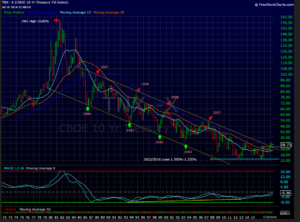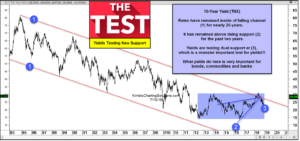(The Weekly Earnings Update will be delayed this coming weekend – it likely wont hit your inbox until Sunday night, July 15th or Monday morning, July 16th, 2018. Thanks for your patience.)
The June payroll report last week showed that “average hourly earnings rose just +0.19%, versus the +0.3% expected and yet the 10-year Treasury yield couldn’t generate any upside volume on the day.
The 10-year yield remains below the key 3.10% – 3.12% from mid-May ’18, as does the 230-year Treasury yield, which remains below both the 3% level and the critical 3.22% – 3.25% yield levels that many technicians are watching.
This chart below from Gary Morrow that was posted in the 2nd half of June was fascinating:

When Gary posted this chart in mid-June ’18 to his blog, Gary noted that if the 10-year Treasury yield closed above 2.915% on June 30, ’18, it would be the first close above the “50-quarter” moving average since Q3, 1985 (Think about that…)
Similarly, Chris Kimble of Kimble Charting Solutions out of Cincinnati, calls this “the biggest test in 25 years” per this morning’s chart from Kimble.
Conclusion: we get CPI and PPI data this week, and then the all-important Q2 ’18 GDP first look is the last week of July. A number of economists think that GDP could be up around 4% – 5%, but the Treasury market’s trading, particularly the 10-year and 30-year yields tell me that even if that is the case, there remains little worry about “unexpected inflation”.
Back in 2003, when the Gulf War kicked off in Mid-March, 2003, and the SP 500 bottomed around the same time after the horrific technology correction in 2001 and 2002, Q3, 2003 GDP was initially reported around 8% – and you could see it coming given the 10-year Treasury yield jumped from 3.10% to righly 4.60% during the 3rd quarter. The GDP gain was mostly productivity-driven as the surge in economic activity only later followed by job and investment growth.
The last time the Treasury complex acted like this was Chairman Greenspan’s “Conundrum” period just a few years later in 2005 and 2006, when, despite the FOMC raising the fed funds rate and the US economy being quite strong, and bond bears being out in full froth (Rick Santelli would give the JP Morgan survey of bond managers once a week from the floor of the old Chicago Board of Trade Treasury pit and 98% of the bond managers were regularly underweight their duration benchmark), rates just would not / could not rise.
Do I think the Treasury market is foretelling a financial crisis today ? No, absolutely not.
My own opinion is that the 10-year and 30-year Treasury yields need more convincing and that is even with the Fed shrinking the balance sheet on top of the fed funds rate increases.
Two outstanding technicians in the form of Gary Morrow and Chris Kimble are telling you to watch what’s going on – something will have to give shortly.
Client’s money market and 5% – 10% short Treasury position (short via the unlevered inverse Treasury ETF, TBF) is unchanged for the year.
But i do worry about it even though there is little value in the corporate, and Treasury markets, not to mention non-US markets that I see.
The yield curve narrowing or flattening as it has, happened previously in August – September, 2016 and then again in September ’17 with the Financial sector acting accordingly.
If the 10-year Treasury yield closes below 2.70% or the early April, ’18 low yields, clients TBF position would be covered.
Jeff Miller, the owner of NewArc Capital and great blogger at www.dashofinsight.com raised the question this week about whether inflation really was on the horizon. Read Jeff’s “Final Thoughts” towards the bottom of the blog where he makes a thoughtful and unemotional analysis of inflation for the average investor.
The 10 and 30-year Treasury yields are now “oversold” – i expect them to work higher over the rest of the summer but maybe not dramatically so.
Maybe former President’s Richard Nixon and Gerald Ford’s “Whip Inflation Now” (WIN) initiatives really worked. (That’s a joke.)
Thanks for reading…

